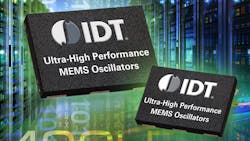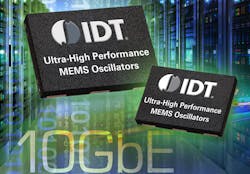MEMS Oscillators Replace Quartz Crystal Oscillators
This file type includes high resolution graphics and schematics.
Virtually every electronic product requires at least one precision timing circuit. Many devices require as many as 10 separate clocks. The typical smart phone or tablet has up to five oscillators. Up until recently, these precision timing circuits were based on quartz crystal resonators. That’s now rapidly changing.
Microelectromechanical systems (MEMS) resonator-based clocks and oscillators are filling applications where their precision and stability can match most crystal circuitry while offering greater reliability, increased ruggedness, smaller size, and even lower cost. IDT and SiTime both are offering new MEMS oscillators.
IDT based its 4H series on its unique and patented piezoelectric MEMS (pMEMS) technology (Fig. 1). These pMEMS resonators can have a native frequency of up to about 100 MHz. When packaged with a phase-locked loop (PLL) multiplier and synthesizer circuitry, they can deliver almost any frequency from 50 MHz to up to 625 MHz with a frequency accuracy of ±50/25 ppm.
1. IDT’s 4H MEMS oscillators can replace quartz crystal clocks in many applications with a frequency range of 50 to 625 MHz. With very low jitter of 100 fs, they suit use in 10-Gbit/s Ethernet applications.
The 4H series boasts very low phase jitter. Over a jitter bandwidth of 12 kHz to 20 MHz, the jitter is less than 300 fs. Over a jitter bandwidth of 1.875 kHz to 20 MHz, the jitter is less than 100 fs, suiting these oscillators for 10-Gbit/s Ethernet applications.
The series also offers Plus-PPM frequency margining, which refers to the oscillator’s ability to be pulled (frequency varied) on the fly over a narrow range of up to ±1000 ppm. Outputs can be low-voltage differential signaling (LVDS), low-voltage positive emitter coupled logic (LVPECL), or CMOS. Its dc power is 2.5 or 3.3 V, and its industrial temperature operation range is –40°C to 85°C.
IDT claims reliability that is up to 40 times greater than that of quartz oscillators with no activity dips, no zero time failures, no stiction issues, and huge shock and vibration resistance. The series includes standard 3.2- by 2.5-mm, 7- by 5-mm, and 5- by 3.2-mm quad flat no-lead (QFN) packages. It targets 10 GE and 40 GE applications like routers and switches, storage clusters, network, and various industrial applications. The devices are sampling now.
SiTime has shipped 150 million MEMS oscillators, representing an 80% market share, and offers more than 40 different programmable MEMS oscillator products. Its SiT15xx series of 32.768-kHz MEMS oscillators targets smart phones, tablets, and other mobile devices, which typically have at least one and often two of the 32-kHz oscillators for timekeeping functions (Fig. 2).
2. SiTime’s SiT15xx series oscillators are the smallest available for 32-kHz timing applications. Several size and power options are available.
The SiT15xx series oscillators combine a MEMS resonator with a fractional-N PLL synthesizer and a set of dividers to provide any frequency from 1 Hz to 32.768 kHz. Stability is typically in the 100-ppm range. Aging is in the ±3-ppm range. Power consumption is a lowly 0.75 µA. The plastic package measures 1.5 by 0.8 by 0.55 mm. And, the devices can handle up to 50,000-g shock and 70-g vibration.
The SiT1534 and SiT1544 are frequency programmable and operate from 1.2- to 3.6-V or 2.7- to 4.5-V supplies, respectively. The SiT1532/3 and SiT1542/3 are fixed in frequency at 32.768 kHz and operate from 1.2- to 3.6-V or 2.7- to 4.5-V supplies, respectively. The 1.2- to 3.6-V devices are available now, while the 2.7- to 4.5-V devices will come along in June.
While MEMS oscillators have yet to fully invade the market space for temperature-compensated crystal oscillators (TCXOs) and oven-controlled crystal oscillators (OCXOs), they are fully capable of replacing other crystal oscillator types commonly at lower cost.
Because these devices are made with standard CMOS silicon techniques, they are easier and cheaper to make than crystal oscillators that require specialized manufacturing and packaging techniques. Some MEMS oscillators are now available for some TCXO uses. It is time to give these devices a second look.
Integrated Device Technology
SiTime Corp.
This file type includes high resolution graphics and schematics.
About the Author

Lou Frenzel
Technical Contributing Editor
Lou Frenzel is a Contributing Technology Editor for Electronic Design Magazine where he writes articles and the blog Communique and other online material on the wireless, networking, and communications sectors. Lou interviews executives and engineers, attends conferences, and researches multiple areas. Lou has been writing in some capacity for ED since 2000.
Lou has 25+ years experience in the electronics industry as an engineer and manager. He has held VP level positions with Heathkit, McGraw Hill, and has 9 years of college teaching experience. Lou holds a bachelor’s degree from the University of Houston and a master’s degree from the University of Maryland. He is author of 28 books on computer and electronic subjects and lives in Bulverde, TX with his wife Joan. His website is www.loufrenzel.com.



